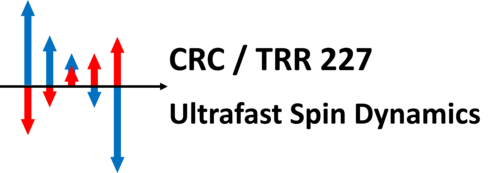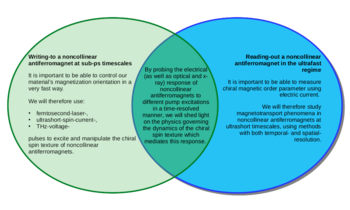B10 - Ultrafast control of Berry-curvature-driven transport via spin-torque excitation of chiral magnets
Our project, new to the second funding period, introduces a new class of materials called ‘noncollinear antiferromagnets’ to the CRC/TRR227. Antiferromagnets are important materials for ultrafast spintronics, because their lack of net magnetization allows for dynamics at THz frequencies alongside component scalability down to technologically-relevant length scales.
However, the collinear antiferromagnets previously studied for spintronic applications have a key limitation: their change in electrical resistance with reorientation of their magnetic order parameter is typically very small. This will create problems when using electric current to read-out the ‘0’ or ‘1’ state of a bit based on such collinear antiferromagnets.
Instead, one solution is to use noncollinear antiferromagnets, whose internal magnetic structure has associated with it a particular chirality (or ‘handedness’). This chiral spin texture breaks time-reversal symmetry, resulting in such materials showing large magnetotransport responses, even in the absence of net magnetization. In other words, electrical read-out of a spintronic component based on noncollinear antiferromagnets would be more reliable and require less energy.
However, so far most studies of noncollinear antiferromagnets have focused on their static properties. Therefore, in this project, we aim to study these materials at increasingly fast timescales, to see if they can attain the ultrafast magnetization dynamics that would be required for their application in next-generation computer and communication technologies.
To achieve this, our project will focus on two key objectives relevant to applications in spintronics, and the intersection between them, as illustrated in the Figure above.
Pursuing these objectives will require us to develop new experimental techniques and microchip geometries, for both writing-to and reading-out chiral magnetic materials. To test these new methods, we will utilize a series of ferrimagnetic materials. These also show ultrafast dynamics, host large electrical and optical measurement signatures, and have magnetic properties that can be tuned by varying their elemental composition. As such, they form the perfect sandbox for optimizing our experimental techniques. In doing so, we also aim to shed light on the mechanism of electrically-driven magnetization ‘switching’ in ferrimagnets, as well as move towards the technologically important goal of using electric current to switch a spintronic bit made of such materials on sub-ps timescales.
Publications (2nd Funding Period 2022 - 2025)
- Interplay of geometrical and spin chiralities in 3D twisted magnetic ribbons
A. M. A. Farinha, S.-H. Yang, J. Yoon, B. Pal, and S. S. P. Parkin
Nature 639, 67 (2025) - DOI: 10.1038/s41586-024-08582-8
- Efficient terahertz spin-to-charge current conversion in IrAl compounds
J. Tong, P. Wang, H. Qiu, T. S. Seifert, I. Kostanovski, S. S. P. Parkin, T. Kampfrath, and O. Gueckstock
Appl. Phys. Lett. 126, 262402 (2025) - DOI: 10.1063/5.0272921
-
Cubic Mn3Ge thin films stabilized through epitaxial growth as a candidate noncollinear antiferromagnet
A. Markou, J. M. Taylor, J. Gayles, Y. Sun, D. Kriegner, J. Grenzer, S. Guo, W. Schnelle, E. Lesne, C. Felser, and S. S. P. Parkin
Appl. Phys. Lett. 125, 022402 (2024) - DOI: 10.1063/5.0206194 -
Terahertz spin-conductance spectroscopy: Probing coherent and incoherent ultrafast spin tunneling
R. Rouzegar, M. A. Wahada, A. L. Chekhov, W. Hoppe, G. Bierhance, J. Jechumtál, L. Nádvorník, M. Wolf, T. S. Seifert, S. S. P. Parkin, G. Woltersdorf, P. W. Brouwer, and T. Kampfrath
Nano Lett. 24, 7852 (2024) - DOI: 10.1021/acs.nanolett.4c00498 -
Generation of out-of-plane polarized spin current by spin swapping
B. K. Hazra, B. Pal, J.-C. Jeon, R. R. Neumann, B. Göbel, B. Grover, H. Deniz, A. Styervoyedov, H. Meyerheim, I. Mertig, S.-H. Yang, and S. S. P. Parkin
Nat. Commun. 14: 4549 (2023) - DOI: 10.1038/s41467-023-39884-6 -
Atomic displacements enabling the observation of the anomalous Hall effect in a non-collinear Antiferromagnet
B. H. Rimmler, B. K. Hazra, B. Pal, K. Mohseni, J. M. Taylor, A. Bedoya-Pinto, H. Deniz, M. Tangi, I. Kostanovskiy, C. Luo, R. R. Neumann, A. Ernst, F. Radu, I. Mertig, H. L. Meyerheim, and S. S. P. Parkin
Adv. Mater. 35, 2209616 (2023) - DOI: 10.1002/adma.202209616 -
Emission of coherent THz magnons in an antiferromagnetic insulator triggered by ultrafast spin–phonon interactions
E. Rongione, O. Gueckstock, M. Mattern, O. Gomonay, H. Meer, C. Schmitt, R. Ramos, T. Kikkawa, M. Mičica, E. Saitoh, J. Sinova, H. Jaffrès, J. Mangeney, S. T. B. Goennenwein, S. Geprägs, T. Kampfrath, M. Kläui, M. Bargheer, T. S. Seifert, S. Dhillon, and R. Lebrun
Nat. Commun. 14, 1818 (2023) - DOI: 10.1038/s41467-023-37509-6 -
Steering skyrmions with microwave and terahertz electric pulses
X.-G. Wang, G.-H. Guo, V. K. Dugaev, J. Barnaś, J. Berakdar, S. S. P. Parkin, A. Ernst, and L. Chotorlishvili
Phys. Rev. B 107, 094404 (2023) - DOI: 10.1103/PhysRevB.107.094404 -
Terahertz spin-to-charge current conversion in stacks of ferromagnets and the transition-metal dichalcogenide NbSe2
L. Nádvorník, O. Gueckstock, L. Braun, C. Niu, J. Gräfe, G. Richter, G. Schütz, H. Takagi, M. Zeer, T. S. Seifert, P. Kubaščík, A. K. Pandeya, A. Anane, H. Yang, A. Bedoya-Pinto, S. S. P. Parkin, M. Wolf, Y. Mokrousov, H. Nakamura, and T. Kampfrath
Adv. Mater. Interfaces 9, 2201675 (2022) - DOI: 10.1002/admi.202201675< -
Setting of the magnetic structure of chiral kagome antiferromagnets by a seeded spin-orbit torque
B. Pal, B. K. Hazra, B. Göbel, J-C. Jeon, A. K. Pandeya, A. Chakraborty, O. Busch, A. K. Srivastava, H. Deniz, J. M. Taylor, H. Meyerheim, I. Mertig, S-H. Yang, and S. S. P. Parkin
Sci. Adv. 8, eabo5930 (2022) - DOI: 10.1126/sciadv.abo5930 -
Origin of helicity-dependent photoconductivity in magnetic and nonmagnetic wires
A. Pandey, R. Dreyer, P. Seyidov, C. Koerner, S. Tirpanci, B. K. Hazra, S. Parkin, and G. Woltersdorf
Phys. Rev. B 106, 174420 (2022) - DOI: 10.1103/PhysRevB.106.174420 -
Atomic scale control of spin current transmission at interfaces
M. A. Wahada, E. Şaşıoğlu, W. Hoppe, X. Zhou, H. Deniz, R. Rouzegar, T. Kampfrath, I. Mertig, S. S. P. Parkin, and G. Woltersdorf
Nano Lett. 22, 3539 (2022) - DOI: 10.1021/acs.nanolett.1c0435

